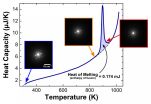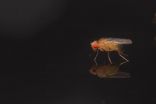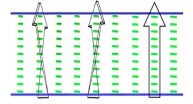(Press-News.org) When studying extremely fast reactions in ultrathin materials, two measurements are better than one. A new research tool invented by researchers at Lawrence Livermore National Laboratory (LLNL), Johns Hopkins University and the National Institute of Standards and Technology (NIST) captures information about both temperature and crystal structure during extremely fast reactions in thin-film materials.*
The combined device will help scientists study new materials and processes used to make advanced technologies, including state-of-the-art semiconductors and flat-screen display devices, says David LaVan, a NIST materials scientist who co-led the study.
Modern electronics manufacturing often pushes the limits of current measurement technology. Making a flat-screen display requires bonding a large sheet of a pure, rare material to an underlying metal substrate with as few defects as possible. To do so, manufacturers typically sandwich a thin film between the two materials and heat it rapidly to high temperatures, causing it to react and bond the metals.
This method usually works, but industry researchers would like to optimize the process. And existing tools to describe what's happening in the reactive thin film provide only incomplete information. One such technique, nanocalorimetry, can track very precisely large temperature changes—at rates up to ,1000 degrees Celsius per millisecond—that occur at a very small scale. Such a measurement can alert researchers to a material's phase transitions, for example, when a metal melts. But nanocalorimetry tells researchers little about the actual chemical processes or microstructural changes they are measuring as a material heats up or cools down.
To study these changes, LaVan's LLNL collaborators Geoffrey Campbell, Thomas LaGrange and Bryan Reed developed a different device, the dynamic transmission electron microscope (DTEM). In traditional transmission electron microscopy, diffraction and transmission patterns made by electrons passing through a thin sample provide information about how the sample's atoms are arranged. But TEM typically requires that the sample maintain one crystal structure for an extended period, as the microscope's detector captures enough electrons to generate an image.
DTEM, by contrast, captures structural information very rapidly. It relies on a pulsed laser to send short, bright blasts of electrons through a sample. LaVan and his colleagues at NIST and Johns Hopkins realized that if the LLNL group's DTEM laser pulses were synched with a rapid temperature rise, the researchers could simultaneously track phase transitions and structural changes in materials they were studying. "It's like peanut butter and chocolate," LaVan says. "If we can somehow get these two instruments working simultaneously, we'll have the whole story."
But first the researchers needed to shrink the circuitry for their nanocalorimeter to a tenth of its original size, so that it could fit inside the microscope. The researchers also needed to write new software to synchronize the microscope's electron pulses with the nanocalorimeter's rapid heating pulses. "To get [the devices] to work together was really a substantial effort from three different research groups," LaVan says.
Finally, LaVan and team member Michael Grapes, a research associate at NIST, and graduate student in materials science Timothy Weihs' group at Johns Hopkins, flew the redesigned nanocalorimeter to Livermore, synchronized it with the DTEM, and ran tests on thin films of materials such as aluminum, whose microstructural and thermal properties are well understood. The scientists found that, as expected, the nanocalorimeter recorded phase transitions at the same time the DTEM recorded structural changes, and both sets of measurements were consistent with their study materials' known properties.
The research team is already moving on to study other, less well-understood materials. Recently, the scientists have used their combined nanocalorimeter-DTEM to measure what happens when aluminum and nickel combine to form thin-film alloys. The team's study provides, for the first time, simultaneous structural and thermal data on this reaction at high heating rates, LaVan says.
INFORMATION:
* M.D. Grapes, T. LaGrange, L.H. Friedman, B.W. Reed, G.H. Campbell ,T.P. Weihs and D.A. LaVan. Combining nanocalorimetry and dynamic transmission electron microscopy for in situ characterization of materials processes under rapid heating and cooling. Review of Scientific Instruments 85, 084902. Published online Aug. 18, 2014.
Strengthening thin-film bonds with ultrafast data collection
2014-10-22
ELSE PRESS RELEASES FROM THIS DATE:
Rescued 'abandoned' penguin chicks survival similar to colony rates
2014-10-22
Abandoned penguin chicks that were hand-reared and returned to the wild showed a similar survival rate to their naturally-reared counterparts, according to a study published October 22, 2014 in the open-access journal PLOS ONE by Richard Sherley from University of Cape Town and colleagues.
The Endangered African penguin population has been rapidly decreasing since 2001. In the Western Cape of South Africa, penguins breed from February to September and moult between September and January, once chicks have fledged. If adult penguins begin the moulting process, a 21 day ...
Camera-traps capture wild chimps' nighttime raiding activities
2014-10-22
Wild chimpanzees living in disturbed habitat may use innovative strategies, like foraging crops at night, to coexist with nearby human activities, according to a study published October 22, 2014 in the open-access journal PLOS ONE by Sabrina Krief from Muséum national d'histoire naturelle and colleagues.
People expanding land use for agriculture and other activities are increasingly encroaching on wild chimpanzee habitat. To understand how chimpanzees are adjusting, researchers used camera-traps to observe chimpanzee behavior during incursions out of the forest into ...
Highly effective new anti-cancer drug shows few side effects in mice
2014-10-22
VIDEO:
This video shows treatment with OTS964 induced cytokinetic defect with inter-cellular bridges that eventually led to cell apoptosis. Cell pictures were taken every 10 min.
Click here for more information.
A new drug, known as OTS964, can eradicate aggressive human lung cancers transplanted into mice, according to a report in Science Translational Medicine. The drug, given as a pill or by injection, inhibits the action of a protein that is overproduced by several tumor types, ...
Males of great bustard self-medicate to appear more attractive to females
2014-10-22
Males of great bustard consume small doses of poison with a dual purpose: to eliminate intern parasites and, especially, to look healthier and stronger before females, allowing them to achieve a greater reproductive success. A team of researchers from the Spanish National Research Council has now suggested for the first time that this function of self-medication could be a mechanism of sexual selection. The study results are published in the PLOS ONE journal.
Juan Carlos Alonso, who led the project, CSIC researcher at the Department of Evolutive Ecology of the Spanish ...
Baby cries show evidence of cocaine exposure during pregnancy
2014-10-22
A new study conducted by University of North Carolina School of Medicine researchers provides the first known evidence of how a similar acoustic characteristic in the cry sounds of human infants and rat pups may be used to detect the harmful effects of prenatal cocaine exposure on nervous system development.
"These findings are important because studies of prenatal drug exposure in humans are always limited by not knowing if infant nervous system damage was due to the effects of a specific drug, such as cocaine, or the effects of other associated factors, such as maternal ...
Secret wing colors attract female fruit flies
2014-10-22
Bright colours appear on a fruit fly's transparent wings against a dark background as a result of light refraction. Researchers from Lund University in Sweden have now demonstrated that females choose a mate based on the males' hidden wing colours.
"Our experiment shows that this newly-discovered trait is important in female choice in fruit flies, and is the first evidence that wing interference patterns have a biological signalling function between the sexes during sexual selection", said Jessica Abbott, a biologist at Lund University.
The extremely thin wings of the ...
Hospital logs staggering 2.5 million alarms in just a month
2014-10-22
Following the study of a hospital that logged more than 2.5 million patient monitoring alarms in just one month, researchers at UC San Francisco have, for the first time, comprehensively defined the detailed causes as well as potential solutions for the widespread issue of alarm fatigue in hospitals.
Their study is in the Oct. 22 issue of PLOS ONE and available online.
The issue of alarm fatigue has become so significant that The Joint Commission, a national organization that accredits hospitals, named it a National Patient Safety Goal. This goal requires hospitals ...
New 3-D display technology promises greater energy efficiency
2014-10-22
WASHINGTON, Oct. 22, 2014—At first glance, the static, greyscale display created by a group of researchers from the Hong Kong University of Science and Technology, China might not catch the eye of a thoughtful consumer in a market saturated with flashy, colorful electronics. But a closer look at the specs could change that: the ultra-thin LCD screen described today in a paper in The Optical Society's (OSA) journal Optics Letters is capable of holding three-dimensional images without a power source, making it a compact, energy-efficient way to display visual information.
Liquid ...
Tropical Depression 9 forms in Gulf of Mexico
2014-10-22
Tropical Depression Nine formed over the western Bay of Campeche, Gulf of Mexico and is forecast to make a quick landfall on Mexico's Yucatan Peninsula. NOAA's GOES-East Satellite captured the birth of the depression.
NOAA's GOES-East Satellite captured an image of the birth of Tropical Depression 9 on Oct. 22 at 1600 UTC (12 p.m. EDT) in the western Bay of Campeche. The clouds associated with the depression stretched over the Yucatan Peninsula and into the western Caribbean Sea.
On Oct. 22, a Tropical Storm Warning was in effect from Celestun to Frontera, Mexico. The ...
Two families of comets found around nearby star
2014-10-22
Beta Pictoris is a young star located about 63 light-years from the Sun. It is only about 20 million years old and is surrounded by a huge disc of material — a very active young planetary system where gas and dust are produced by the evaporation of comets and the collisions of asteroids.
Flavien Kiefer (IAP/CNRS/UPMC), lead author of the new study sets the scene: "Beta Pictoris is a very exciting target! The detailed observations of its exocomets give us clues to help understand what processes occur in this kind of young planetary system."
For almost 30 years ...






